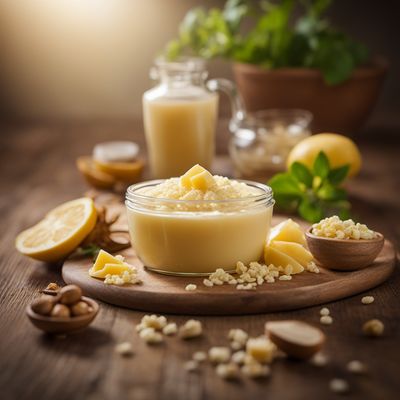
Ingredient
Goat tallow
"The Golden Elixir: Unveiling the Secrets of Goat Tallow"
Goat tallow is a rendered fat obtained from the adipose tissue of goats. It is solid at room temperature, with a creamy white color and a smooth, waxy texture. This ingredient has a rich, savory aroma and imparts a distinct, buttery flavor to dishes. Its high smoke point makes it ideal for frying, sautéing, and roasting, while its creamy consistency adds depth and richness to both sweet and savory recipes. Goat tallow is known for its ability to enhance the tenderness and juiciness of meats, making it a prized ingredient in traditional cuisines around the world.
Origins and history
Goat tallow has a long history dating back to ancient times. It has been used in Mediterranean, Middle Eastern, and African cuisines for centuries, where goats have been an integral part of the culinary culture. Goats were one of the first domesticated animals, and their tallow was highly valued for its versatility and nutritional benefits. In many cultures, goat tallow was not only used for cooking but also for medicinal and cosmetic purposes. Today, goat tallow continues to be cherished in traditional recipes and is gaining recognition in modern culinary practices.
Nutritional information
Goat tallow is a good source of healthy fats, providing essential fatty acids like omega-3 and omega-6. It is also rich in fat-soluble vitamins A, D, E, and K. With approximately 115 calories per tablespoon, it offers a concentrated source of energy.
Allergens
Goat tallow may pose a risk to individuals with goat milk or dairy allergies, as it is derived from the fat of goats.
How to select
When selecting goat tallow, opt for a product that is pure and free from additives or preservatives. Look for tallow that is creamy white in color, with a pleasant aroma. It should have a smooth, waxy texture and be free from any off-putting odors or discoloration.
Storage recommendations
Store goat tallow in an airtight container in a cool, dark place, such as a pantry or refrigerator. It can be kept at room temperature for short periods, but refrigeration will help extend its shelf life. Properly stored, goat tallow can last for several months.
How to produce
To produce goat tallow at home, start by obtaining the fat from a trusted source, such as a local butcher or farmer. Trim away any excess meat or connective tissue from the fat. Cut the fat into small pieces and place them in a heavy-bottomed pot. Heat the pot over low heat, allowing the fat to slowly melt. Stir occasionally to prevent sticking. Once the fat has completely melted and any impurities have risen to the surface, strain the liquid through a fine-mesh sieve or cheesecloth into a clean container. Allow the tallow to cool and solidify before use.
Preparation tips
Goat tallow can be used as a cooking fat for frying, sautéing, and roasting. Its high smoke point of around 400°F (204°C) makes it suitable for high-heat cooking methods. It can also be used as a substitute for butter or oil in baking, adding a unique flavor and richness to pastries and bread. When using goat tallow, start with small amounts and adjust according to taste. It can be melted and drizzled over cooked vegetables or used as a base for flavorful sauces and gravies.
Culinary uses
Goat tallow is commonly used in Mediterranean and Middle Eastern cuisines for frying and roasting meats, vegetables, and grains. It is also used in traditional dishes like Moroccan tagines and Greek moussaka, where its rich flavor adds depth to the final dish. In baking, goat tallow can be used as a substitute for butter or oil, lending a unique taste to cookies, cakes, and pie crusts.
Availability
Goat tallow is commonly available in regions where goat farming is prevalent, such as the Mediterranean, Middle East, Africa, and parts of Asia. It can also be found in specialty stores or online retailers catering to culinary enthusiasts.

